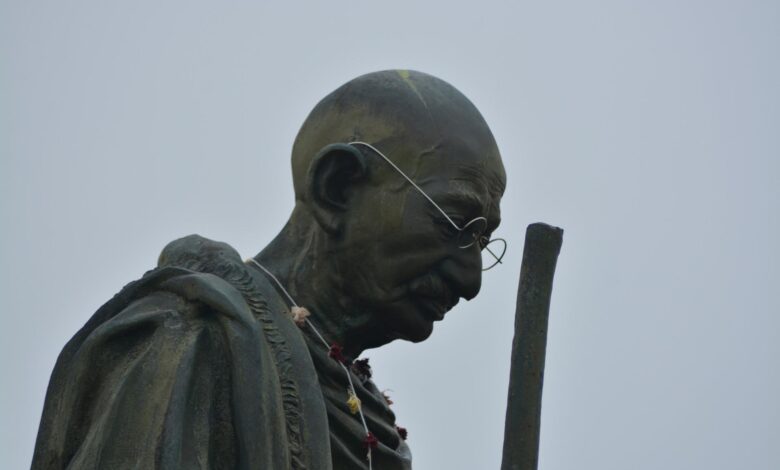Gandhi’s Salt March: A spiritual journey to freedom

 March 12, 1930. The stage was set. The walk for liberation had begun. Mahatma Gandhi had carefully sought his strategy and decided to begin his 241-mile march from Sabarmati to Dandi. The occasion — to break the salt tax imposed by the British.
March 12, 1930. The stage was set. The walk for liberation had begun. Mahatma Gandhi had carefully sought his strategy and decided to begin his 241-mile march from Sabarmati to Dandi. The occasion — to break the salt tax imposed by the British.
The 61-year-old Gandhi had begun the Dandi March or Salt Satyagraha with 79 satyagrahis, setting out on foot for the coastal village of Dandi, Gujarat, over 390 km. On the first day itself, Gandhi marched for 21 km and halted in the village of Aslali, where he addressed a crowd of about 4,000. This biggest non-violent Satyagraha movement continued till April 6, 1930, when at the Dandi beach, Gandhi picked up a lump of salt symbolically claiming his right to make salt on behalf of his countrymen.
The idea and essence of non-violence and the relentless pursuit of truth and freedom exemplified Mahatma Gandhi’s principles of truth (satya) and non-violence (ahimsa) throughout the Dandi March. Gandhi’s life was a testament to his unwavering commitment to expanding the human capacity for love and resilience in the face of adversity.
The Dandi March, to date, stands as one of the most pivotal moments in India’s struggle for independence. It was a symbolic act of defiance against British colonial rule, where Gandhi called in ‘world sympathy’ in his ‘battle of right against might’. But more profoundly, it was a spiritual journey of the man himself in his quest for truth and firm affirmation of liberating the thousands, suffering the atrocities of the Raj. This journey – somewhat like the pilgrim’s progress – elevated Gandhi as the leader of the masses, whose soul he had ignited.
Professor Gene Sharp, renowned for his studies on nonviolent resistance, noted, “Gandhi’s Dandi March was a master class in strategic nonviolent action. It showcased the power of collective civil disobedience and moral force to challenge entrenched authority.”
Gandhi’s ability to inspire voluntary participation in the Dandi March was a testament to his leadership and understanding of human psychology. Writer Arundhati Roy reflects on this aspect, stating, “Gandhi’s genius lay in his ability to awaken the dormant spirit of resistance within ordinary people. The Dandi March was not merely a political protest; it was a spiritual awakening for millions.”
The voluntary participation of thousands of people in the Dandi March – as Gandhi marched from one village to the other and people joined – was not coerced but stemmed from a deep conviction in Gandhi’s message of his fight for truth, liberation and the conviction of non-violent satyagrahis over brute force. It wouldn’t be an exaggeration to state that Gandhi’s emphasis on moral and spiritual transformation resonated deeply with the Indian ethos. People joined the Dandi March not out of fear or compulsion but out of a shared belief in the righteousness of the cause.”
Gandhi’s emphasis on moral and spiritual transformation struck a chord with the Indian ethos, deeply rooted in the principles of dharma (righteousness) and ahimsa (non-violence). His message resonated with people across various strata of society, transcending barriers of caste, creed, and religion. Gandhi’s ability to connect with the masses on a moral and spiritual level was instrumental in mobilizing support for the Dandi March.
Initially met with scepticism by the Congress Working Committee, Gandhi’s bold selection of the salt tax as the focal point of resistance left figures like Jawaharlal Nehru and Divyalochan Sahu ambivalent. Sardar Patel proposed a land revenue boycott instead. Even the British colonial administration, including the Viceroy himself, Lord Irwin, remained unperturbed, dismissing the salt protest as inconsequential.
However, Gandhi’s strategic insight illuminated the profound significance of this seemingly mundane commodity. For Gandhi, “Next to air and water, salt is perhaps the greatest necessity of life.”
Gandhi’s choice struck at the heart of British economic exploitation in India, highlighting the power of simplicity and the intrinsic dignity of common necessities in the pursuit of justice and liberation.
The Dandi March, as a symbolic act of defiance, provided ordinary Indians with a platform to assert their agency and challenge the authority of the British Raj peacefully. It became a rallying point for the burgeoning Indian nationalist movement and a testament to the power of collective action grounded in moral and spiritual values.
In essence, the voluntary participation in the Dandi March was a manifestation of the deep-rooted belief in the righteousness of Gandhi’s cause. It reflected the resilience, courage and commitment of the Indian people to pursue freedom and justice through non-violent means.
The spiritual dimension of the Dandi March cannot be overstated. Gandhi saw it as a form of self-purification, both for himself and for the nation. Mahatma Gandhi’s concept of satyagraha was not just a political strategy; it was a path to self-realisation; and the Dandi March was a pilgrimage of the soul, a journey towards truth and freedom. It was a transformative journey for both Gandhi and the nation.
Rabindranath Tagore’s observation about Gandhi’s transformation during the Dandi March holds profound significance. Tagore underlined that Gandhi’s transition from a political leader to a spiritual force was evident in his actions and the principles he upheld. As he walked the dusty roads of India, gathering followers along the way, Gandhi embodied the essence of his philosophy — that love and non-violence are the most potent weapons against oppression.
The breaking of the salt laws at Dandi on April 6, 1930, was not just a symbolic act of defiance; it was a declaration of independence from the shackles of oppression. Gandhi’s spiritual conviction was evident in his refusal to resort to violence, even when provoked to the extreme – followed by the resilient act of the satyagrahis who went down as blows after blows and lathi charges were hurled at them and yet continued their journey, (read mission), with complete steadfastness and non-violence.
Mahatma Gandhi’s transformation during the Dandi March was not only personal but also had a profound impact on the Indian psyche. He became a beacon of hope for millions, inspiring them to embrace his non-violent methods in their daily lives. His ability to mobilize ordinary people in the pursuit of truth and freedom was a testament to the strength of his spiritual convictions.
The legacy of the Dandi March reminds us that true power lies not in force but in the transformative power of love and compassion.





